Ahwar’s Artists: The Story of the People
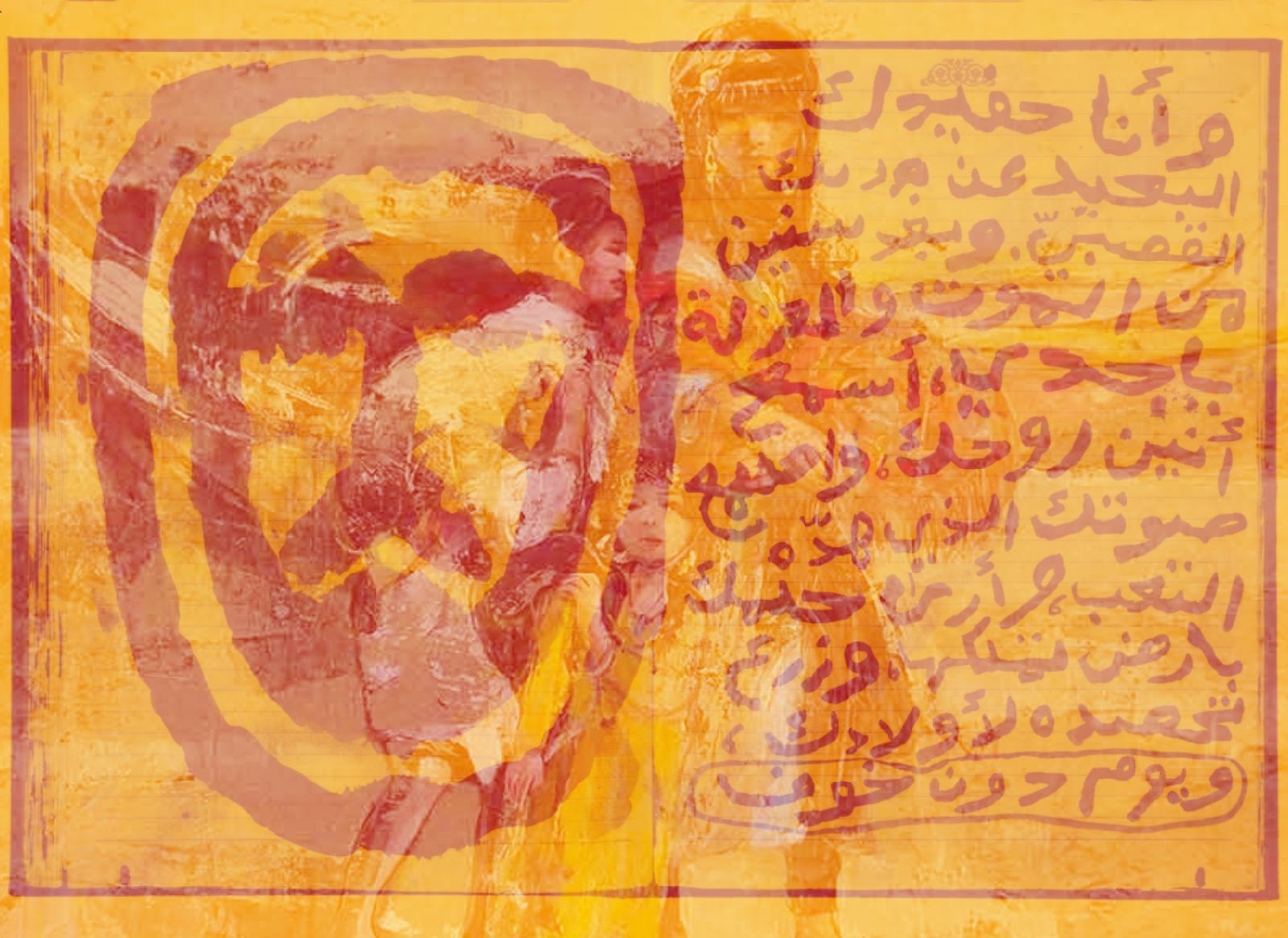
Throughout history, artists documented the main events of their era with painting and sculpture, and this phenomenon later increased during the 19th century and then became a major aspect of the 20th century, which was characterized by wars, and ethnic and political migrations.
Including the Ahwari migration, the Ahwari migration is rarely discussed, and sometimes does not exceed the local media, In a war-torn country, migration continues and is not told by its people, therefor, the Ahwari migration deserves to be highlighted, on the lived experience of our people who are living through a century of bloody violence.
The Ahwari migration is defined as an inevitable result of the economic and social policies that shaped the relationship of the Iraqi state with the marshes and its people, and in a look at our crises and reading our history, we have to look at the creative activity that documented and expressed crucial stages in our cultural and social transformations.
The Ahwaris have emigrated since the beginning of the 20th century in many waves, first in the era of the Iraqi monarchy until the end of feudalism, then in the Iran-Iraq war, and then after the genocide and forced displacement in the 1990s, and the migration continues until now in recent years, due to the destruction plans implemented by the government, the extension of military borders, drying of the marshlands for the benefit of companies and the confinement of water for the central areas in Iraq and Iran.
Among the painters who painted this migration are three artists who ended up in the diaspora away from Ahwar in a second alienation, namely Mahood Ahmed, Amer Badr, and Sadiq Kuisch, in each of their paintings a story, and while the world ignores that novel, the paintings sail in a sea of details and insightful visions of the past, of a world we did not live in, the lack of justice and nostalgia, and at the same time the beauty of the Garden of Eden from which they were exiled.
Mahood Ahmed
Mahhood Ahmed was born in 1940 in Hor Hawiza at a time when the feudal system dominated the shoulders of the majority in the southern fiefdoms. Mahood immigrated to Baghdad and there he completed his studies at the Institute of Fine Arts in Baghdad, and in 1967 he received a master’s degree in arts from the Institute of Surrey Proskova, and then he obtained a doctorate in art philosophy from the Higher Institute for Theoretical Studies in Moscow, what he learned from the Russian revolutionary drawing school of “socialist realism” tried to employ him in a style dominated by legendary realism, and of course not only immigration paintings, the artist sought to prove that what he sees embodied in reality is a picture of a dream Restores all the marshes, their legends, their people, their traditions, their tragedies, and their nature.
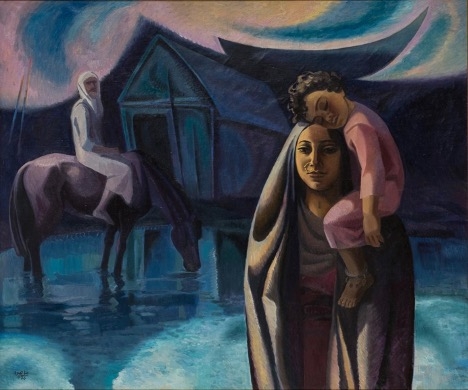
Mahood used to say: “I try to express events through legends in a modern spirit, so I mention the elements of my people, their life and their sacrifices not directly, but symbolically as if we do not deal with sight, but the insight is the one who is the common one between us and our people.” He combined the ancient legends with his paintings of the marshes, sometimes as stories and sometimes as symbols that you find when you look at the details of the painting, Mahood, nicknamed as the Marsh Boy, was painting his culture that is about to be forgotten, and he left life without returning to his land.
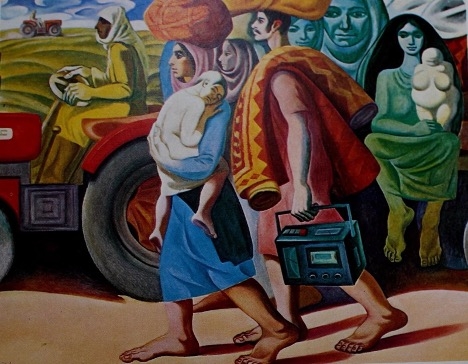
“The Return of Farmers” is a painting by Mahood Ahmed that tells a chapter of the Ahwari migration. After the major cities were filled with immigrants because of the feudal system, the government passed laws to return the population to the countryside, where there is no law and the population returns to a fragile economic environment that will be broken in every political crisis, Mahood shows the faces of immigrants to a strange destination, “Baghdad”, a world different from what they used to, different from their lives under the whip of feudals and the customary laws of tribes that the state has partially handed over power over its small confederacies.
Also in the painting, the traditionally woven carpets appear, turquoise-colored faces that seem to be ancestors watching the caravan heading for a hard fate with suffering, and a statue of gods embraced by a woman sitting on the side of the road, it is not lost in the fact that the statue is for the mother gods, which is the symbol of fertility and motherhood in Mesopotamia, its symbolism in the painting to save the caravan from destruction gives a deep sense of the connection that Mahood sees in our Ahwari society with our Mesopotamian ancestors, and a feeling that we are in the darkest turns of our history, we have brought with us our heritage without leaving it behind us, in our hands, our words, and our lives.
Amer Badr
Amer Badr is an Ahwari artist born in Baghdad in 1975. He studied painting at the Institute of Fine Arts in Baghdad in 1997, and then completed his studies at the Faculty of Fine Arts in Baghdad in 2001. He emigrated to the Netherlands in 2010 where he lives and works there, in his personal exhibition “Southern Tales” in the Dutch city of Dunhakh. The artist Amer Badr presented 16 paintings that restore passages from his childhood in the marshes in the eighties, during the Iran-Iraq war (1980-1988) where the south became the main line of the war, “I remember escaping to the unknown” says Amer Badr in his exhibition, which sees works that reflect the sentence of the events experienced by the Ahwaris, referring in his presentation to the control of the feudalists In the territory of the region and its production since the beginning of the last century, all the way to the war, where the marshes were dried as a way to support the suppressing of the rebellion that ended by a Genocide.

Amer paints with oil his paintings that immortalize what he lived and what his grandmother told later, it is no secret that most of the painters have focused on the women of Ahwar in particular. In his paintings, he paints the women he knew in his childhood and the women who sit in the reed houses busy with their work, and the scenes of painful displacement from their historical homeland in which they have withstood for thousands of years.
Amer Badr’s paintings are characterized by their colors that seem dim in the background and dark in the drawing of the characters, as if the painting tells us that it is part of an excerpt from this world, and what is behind it is covered with fog, unknown and mysterious, and is dominated by migration and drought. Either the focus on the dark colors of the carpets that were often carried or told by women in his paintings, tells us about an important chapter of our history and culture. In the nineteenth century, carpet knitting became popular in the Ahwari society, and its bright colors and symbols were common, which are engraved in tattoos and irritated tales. The carpets themselves, narrate part of our history, its spread, colors and symbols, and then the risk of extinct at the present time being, Amer Badr used to make women carry their culture In their hands, because they have always preserved this culture from the danger of being forgotten.
Amer says on his official website: “My paintings are a reflection of the memories and feelings I had during my childhood. My works is inspired by the culture, customs and traditions of Iraq where I grew up. Colors, impressionist and expressive forms are a shift in my mind and a longing for my family. While my previous paintings have focused on the social and human side of life, my recent works express the negative effects of war on people, countries and the suffering they create for human beings, the intertwining of the memories of former Iraq with my impression of current Europe is my creative driving force. My work echoes in the inner feelings and strong emotions that exhausted me, from the feeling of loss, I try to find my way with hope, longing home, dancing with joy and desire, despite the continuation of the voice of war,” he also says: “Feudalism since the beginning of the last century, the war, which drained the marshes that caused terrible effects on nature, are the reasons that led to the displacement of people from their homes and community to major cities. The Ahwari people enjoyed a beautiful social mix and peaceful coexistence between their different communities. A society full of stories of love, poetry, emotions, legends, eternity and sadness, all these events had a clear and direct impact on my experience, so I dealt with this era with its human and aesthetic dimensions.”
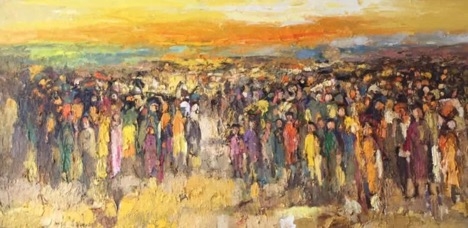
Sadiq Kwaish
Sadiq Kwaish is an Ahwari artist living in the Netherlands, born in 1960, and his works are located in personal and public collections, including the British Museum, the Arab Museum of Modern Art, the Los Angeles County Museum of Art, the Houston Museum of Fine Arts and the Burjeel Foundation for the Arts. Koich highlights his work and his experience in art for more than three decades with immigration and displacement. His new exhibition continues at the “Stedelijk Museum” in Amsterdam, and includes a series of works he has been carrying out during the last three years through multiple media.
The mural “Sing as Southerners Sing”, which consists of thirty paintings that form a whole form a mural with a size of 3x7 m, with the installation of Mawaweel in the voice of the Iraqi singer Salman Al-Mankub (1918 - 2011), who presented hundreds of songs from the Iraqi heritage and composed most of them using oud, violin and venture instruments. Sadiq Kwaish chose Salman’s voice in his work as a reminder of a forgotten land whose songs have reached the ears of various people, as the world of Ahwar.
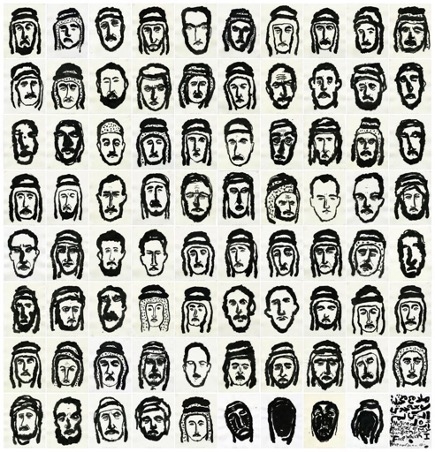
It also shows an animation film entitled “The River That Was in the South” (five minutes), which was carried out by the artist in black and white in 2019 and deals with his relationship with his father, and the film forms part of a work with the same title, as it goes beyond with black-black paintings that express the permanent sense of displacement in exile and distance from home in a language overflowing with nostalgia. In addition to this work, the exhibition includes other projects produced by the artist during this period, including his last work, which was not previously shown under the title “Those Houses behind the Army Channel”, which means the houses of the city of the revolution neighborhood in Baghdad, which nowadays turned its name into Sadr City, a work that deals with The beginning of the establishment of this city to be a residence more like a “ghetto” for Ahwari immigrants from southern Iraq because of the feudal system at that time.
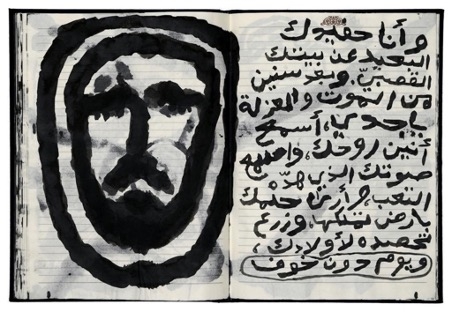
Drawing on the history of his family’s displacement, Kwaish is doing work aimed at making a wide resonance with viewers, he says: “The goal of my work is not political, it’s about asking questions about what happens to oneself when one is forced to leave his homeland and move to live somewhere else, I think this is something that no one can cure, and you bear this burden to anywhere you can travel or settle down after that, the matter remains stuck in the person’s heart permanently.” Also: “But the exhibition was also a personal exercise to deal with the constant feeling of displacement that he will never get rid of, despite many years away from Iraq, one carries this feeling that he is permanently out of his place, and that he is never at home, neither abroad nor in Iraq.”
Kawish also wrote a message revealing his feelings, describing nostalgia and the feeling of loss and alienation about his homeland, the marshes. As he says, and as he says about our mouthpiece, he always has the feeling that he is never in his homeland, neither in Iraq nor outside it. He says in the translated letter from English: “These are visions coming from a far, from a generation I haven't seen, and a life I haven't lived, yet I grew up in the arms of its legacy. It is my grandfather's generation who lived up suspended between his own southern heaven and the toll of its existence there.
There, where the fistful power of feudalism and misery, where the beauty of life mixed up with Cruelty bred an endless vortex of dreams and nightmares To get over their wasted dreams and the Phantoms of agony and loss; Sorrow and grief would identify their world and encompass their perception of things to become a feature of their existence.
And with a devotion that is a mixture of lust for life and abstemiousness, they are to create songs of sorrow and tales where happiness takes the color of grief and, Where anguish is replaced with joy, where reality blends with the myth, with words of agony, love Yearnings, partings, desolation, death and absence of justice, this generation lives in that southern garden, but it cannot live his life or determine the shape of its fate, despite all impressions, aspirations and fears, leaving behind the crops And the stories, their legacy is their dreams that carry their songs and houses built with canes, threatened by migration, hoping that they will find a better life, and the dreams of migration may always seem rosy, but the path of migration, shining like gold, as a bright light followed by the mirage, unaware that they will end up living on the edges of cities, this migration will enter its third generation, burdened with burdened, with misery and loss, they are eternal immigrants standing on those edges with the same old passion, and with this passion, I stand up here, on the side of the canals in Amsterdam, I watch the ways of departure, and listen to the task of the nerve that connects me to that southern country that carries me to that slim river, the River, the Rifai River, swims on the back of the marshes On his way he waters the chants of love and hope, and then fades after drought, absence and isolation, these drawings, are an attempt to reveal the visions of these early ancient immigrants, they belong to us, we who are still in a state of vibration and movement, driven by eternal desire, we depict the sky that we will stand on its edges forever.”